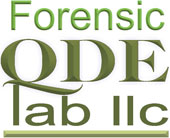Forensic Document Examination
If you have ever contacted a forensic document examiner with an issue of authentication or a question about a possible change made to a document, one of the first questions she will ask is, “Do you have the originals or just copies?”
Many times, the original document is nowhere to be found. I hear this most often when there is a signature in question. This is especially true with bank records and documents that are submitted to county offices. All that I have to work with is a copy. Or worse, a copy of a copy of a copy…
In the absence of original documents, the analysis of a questioned document is limited to the features that survive the copying process. This can be likened to identifying a person behind a cloudy window; the basics are there, but details are missing. What we call the “three-dimensionality” of the original document is lost. Not to mention that if the copy is a copy of a copy, the details become increasingly difficult to verify.
So, with this understanding, here are some of the highlights of why the level of certainty of an expert opinion is affected by having only copies to analyze.
Loss of detail – intricate pen direction
Pen direction is a very critical factor in the evaluation of handwriting. Copies make it difficult and sometimes impossible to follow intricate writing movements essential for reaching accurate conclusions. Not only is direction important, but also the pressure of the writing instrument can tell us more about the condition of the writer and the writing surface.
Overall loss of detail – beginning and ending strokes
Natural writing is frequently demonstrated by the tapered beginning and ending strokes. The copying process can eliminate these tapered strokes and make them appear as blunt or chopped off in an otherwise naturally executed signature. Sometimes, blunt ending and beginning strokes are characteristics of “signatures” produced through simulation (emulation) or tracing process.
Loss of detail – evaluation of line quality
A photocopy of a genuine signature may show “lumpiness” or lack of smooth, clear-cut strokes, resulting in poor line quality (record of the strokes), when in reality the original document may contain good line quality upon examination. An early-generation photocopy, in some cases, may embody good line quality and be used as a basis for a tentative or qualified opinion.
Unexpected visual results
If a genuine signature is written under uncommon circumstances, the copying process may make it appear as containing the “tremor of fraud,” giving the appearance of poor line quality. With the examination of the original questioned document, it may be possible to determine that there is an explanation for what appeared to be poor line quality in the copy. For example, one may find that in the copy of the signature appeared tremulous because it was written on a rough surface such as a briefcase, the hood of a car or other textured surface.
Hesitations
Hesitations, a pause in the writing line, generally cannot be detected in copies. Hesitations are common artifacts of “forged” signatures or can be a habit of the true writer. With only copies for evidence, this significant characteristic cannot be determined.
Patching
Patching is the careful retouching sometimes seen in “forged” signatures as a result of the “forger’s” perception that the simulation or tracing needs some mending to pass it off as genuine. It is also seen in some people’s natural writing but generally cannot be detected and evaluated in copies.
Fraudulent manipulations
Evidence of cut-and-paste of a genuine signature from a genuine document onto the questioned document cannot always be detected, especially if the genuine signature was added by using computer software.
Tracings
Traced signature “guidelines” consisting of pencil, carbon or indentations produced with a stylus which correspond with the outline of the genuine signature cannot be conclusively established via the examination of a copy.
Writing Instrument
While sometimes it is possible with photocopies to make a preliminary determination as to the type of writing instrument used, a definitive determination cannot be made without the original document.
Paper
Paper can sometime be dated as to its first date of availability through use of watermarks, but obviously this determination cannot be made based on photocopies. Neither can the document be compared as to any other physical characteristics such as the thickness or color value of the paper.
Indentations
Occasionally, “indented writings” can be detected with oblique/side lighting or by using a laboratory device on original documents, revealing key information that could resolve some critical issue. While this technique can be applied to photocopies for other purposes, it will not reveal the indentations that are present in the original document.
Measurements
Accurate measurements cannot be made on photocopies. As a rule, photocopiers do not precisely reproduce the document being copied. Copies impede the reliability of tests that include measuring lines and spaces to determine alterations or insertions in a document.
Three-dimensional vs. two-dimensional images
Photocopies are two-dimensional representations of original documents which are three-dimensional. Originals disclose all of the physical and optical features of the printing processes and handwriting features. On the other hand, photocopies are high contrast images which leave out all of the mid-tones present in the original images.
THE BOTTOM LINE
Originals are always the best evidence. For a more productive result, try to provide originals, both questioned documents and known samples, for your document examination as soon as they become available.
For more information or help with your handwriting signature analysis or document examination you can contact me at ALLIANCE FORENSIC SERVICES in Escondido, CA. 888-760-0339
Questioned Document Examination in the Digital AgeMain Reasons for Questioned Document ExaminationFinding the Right Kind of Handwriting ExpertHow Can I Prove Forged Signatures Aren’t MineWhat Training Does a Forensic Handwriting Expert Need?Choosing the Right Forensic Document Examiner Can Make or Break a CaseFinding a Trusted Source for Forensic Document AnalysisCan a Document Examiner Help Clear My Name?
